‘A Short History of 32 to 38 Queen Street, Belfast’ by Richard Graham
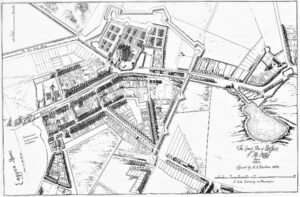 Originally known as David Street on leases of 1806, the present name of Queen Street came into being by 1810. The reason for the distinct angle on the street, at its junction with College Street, is because the original street was laid out using the line of part of the old town defences.
Originally known as David Street on leases of 1806, the present name of Queen Street came into being by 1810. The reason for the distinct angle on the street, at its junction with College Street, is because the original street was laid out using the line of part of the old town defences.
In Georgian times, the street was largely inhabited by merchants, and as time went on many fine houses from this period were built on the street.
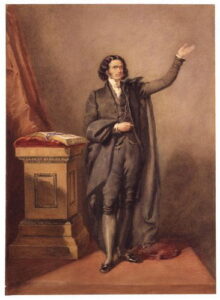
Unknown artist, drawing, c 1823
By the 1860s there was an Irvinite Meeting House on this site at 34 Queen Street which soon translated itself into a Catholic Apostolic Church. Contrary to what you might think, the Catholic Apostolic Church was a Christian denomination and Protestant sect which originated in Scotland around 1831 and later spread to Germany and the United States. It was a remarkable church in which the members believed in the imminent second coming of Christ, combining revivalist enthusiasm with liturgical worship.
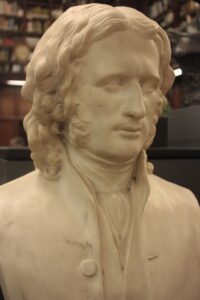 Its founder Edward Irvine was born in Annan, Annandale, Scotland in 1792, and is largely credited with the church’s establishment. After gaining his MA at the University of Edinburgh, he was ordained into the Church of Scotland in 1815, but during that time began to investigate other means of spiritual worship which eventually led to his expulsion from the Church of Scotland and the setting up of the sect which later became known as the Irvingian Movement.
Its founder Edward Irvine was born in Annan, Annandale, Scotland in 1792, and is largely credited with the church’s establishment. After gaining his MA at the University of Edinburgh, he was ordained into the Church of Scotland in 1815, but during that time began to investigate other means of spiritual worship which eventually led to his expulsion from the Church of Scotland and the setting up of the sect which later became known as the Irvingian Movement.
There is little doubt that Irvine would have visited Belfast on several occasions in order to promote his church, but he died “worn out and wasted with labour” in 1834 in Edinburgh at the age of 42.
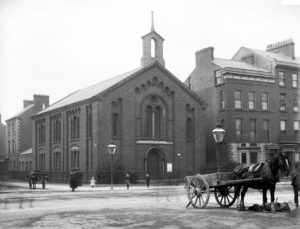 Queen Street, like much of Wellington Place in the early 1800s was largely residential, with many fine Georgian houses on the thoroughfare. Just within a few yards away at its junction with Wellington Place was another church – the Evangelical Union Chapel, designed by John Boyd in 1858, showing that the area was very different in character to that found today.
Queen Street, like much of Wellington Place in the early 1800s was largely residential, with many fine Georgian houses on the thoroughfare. Just within a few yards away at its junction with Wellington Place was another church – the Evangelical Union Chapel, designed by John Boyd in 1858, showing that the area was very different in character to that found today.
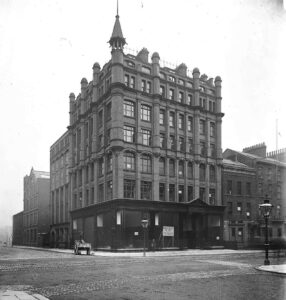 As the area changed from residential to commercial, this church was replaced by Kingscourt, a seven-story warehouse, designed by the architect WJ W Roome and opened in 1901. It later became the home of the Athletic Stores, until its destruction by fire in 1974. This warehouse was replaced by a modern office building named Sun Alliance House in 1986 which stands next to the £28 million Aparthotel development being constructed on the site at 32-38 Queen Street today.
As the area changed from residential to commercial, this church was replaced by Kingscourt, a seven-story warehouse, designed by the architect WJ W Roome and opened in 1901. It later became the home of the Athletic Stores, until its destruction by fire in 1974. This warehouse was replaced by a modern office building named Sun Alliance House in 1986 which stands next to the £28 million Aparthotel development being constructed on the site at 32-38 Queen Street today.
So, who would have occupied the houses on Queen Street? Well, in 1868, Miss Stravelly ran a school for young ladies at No 24, whilst Miss Ussher ran a governess and servants’ registry office at no 34. To give you some idea of the former residential nature of the street an interesting photograph exists of some of the former Georgian houses on the thoroughfare just before they were demolished in 1913.
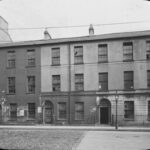
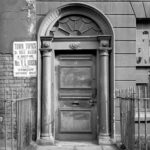
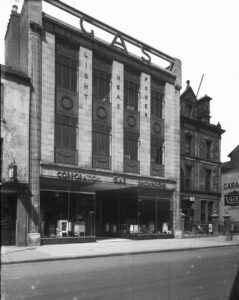 One of the most important civic buildings to be erected on Queen Street was the Hospital for Sick Children in 1878 by Thomas Jackson. The hospital had originally been established at 25 King Street before moving here in 1879. This building remained in use as a children’s hospital until its successor was built on the Falls Road in 1932. This unique building, in Scrabo sandstone, was then taken over as a police barracks which closed in 2000, following the peace process. It can be seen in use as an RUC station beside the Corporation Gas Showrooms of 1871 in this photograph of 1930.
One of the most important civic buildings to be erected on Queen Street was the Hospital for Sick Children in 1878 by Thomas Jackson. The hospital had originally been established at 25 King Street before moving here in 1879. This building remained in use as a children’s hospital until its successor was built on the Falls Road in 1932. This unique building, in Scrabo sandstone, was then taken over as a police barracks which closed in 2000, following the peace process. It can be seen in use as an RUC station beside the Corporation Gas Showrooms of 1871 in this photograph of 1930.
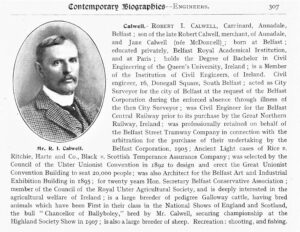 By the end of the 19th century, the CAC church was no longer in use and the site was earmarked for commercial development. Work began at number 36 on a large red brick warehouse designed by Robert Inkerman Calwell in 1898 for the printing and stationary firm of John Dickinson & Company who had occupied smaller premises on the site since 1868. They specialised in linen ornament and fancy box manufacture. Calwell was born at Annadale, Belfast in 1854 becoming a respected engineer and architect, He was civil engineer to the Belfast Central Railway before becoming acting Belfast City Surveyor, a highly regarded position in the city.
By the end of the 19th century, the CAC church was no longer in use and the site was earmarked for commercial development. Work began at number 36 on a large red brick warehouse designed by Robert Inkerman Calwell in 1898 for the printing and stationary firm of John Dickinson & Company who had occupied smaller premises on the site since 1868. They specialised in linen ornament and fancy box manufacture. Calwell was born at Annadale, Belfast in 1854 becoming a respected engineer and architect, He was civil engineer to the Belfast Central Railway before becoming acting Belfast City Surveyor, a highly regarded position in the city.
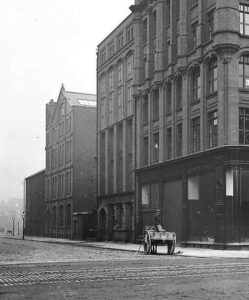 The warehouse he designed for the site, and which opened in 1899, was an impressive affair. Built by one of the city’s leading building contractors, W H Stephens & Co, at five stories high it dominated this side of the street. It was however the end of the area being residential and the building became typical of those warehouses which would proliferate the area for the next 80 years. In this image, the former Georgian houses can still be seen on Queen Street at its junction with College Street.
The warehouse he designed for the site, and which opened in 1899, was an impressive affair. Built by one of the city’s leading building contractors, W H Stephens & Co, at five stories high it dominated this side of the street. It was however the end of the area being residential and the building became typical of those warehouses which would proliferate the area for the next 80 years. In this image, the former Georgian houses can still be seen on Queen Street at its junction with College Street.
The building was designed for use by John  Dickinson & Co, one of the largest and most important printing and stationary companies in the UK. Founded in Hertfordshire in 1810 by John Dickenson, the company pioneered several innovations in paper making under the Lion Brand. During the time the company remained on Queen Street, it acquired the well- known Basildon Bond range of stationary which was distributed from this building to most parts of Ireland.
Dickinson & Co, one of the largest and most important printing and stationary companies in the UK. Founded in Hertfordshire in 1810 by John Dickenson, the company pioneered several innovations in paper making under the Lion Brand. During the time the company remained on Queen Street, it acquired the well- known Basildon Bond range of stationary which was distributed from this building to most parts of Ireland.
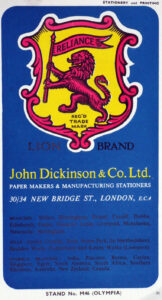
Another leading printer and stationer operated from the opposite side of the street – this was Robert Carswell & Sons at no 35-39. Carswell’s Buildings was erected in 1895 and the building is currently undergoing refurbishment as “The Printworks” a retail and office development of some 50,000 square feet, and reflective of the high degree of investment in the area.
As time went on and into the 20th century, more warehouses were built on the site of 32-38 Queen Street with an even larger six story building being erected at no 32 and stretching down College Street for Nicholson & Morrow, Wholesale Warehousemen. They would have supplied all forms of shops and retailers and had the unique telegraphic address of “Fancies, Belfast” giving an indication of the products they sold!
There were three such warehouses to be found on the site in the first two decades of the 20th century – all three can be seen in this photograph from 1946 – just after the end of the second world war.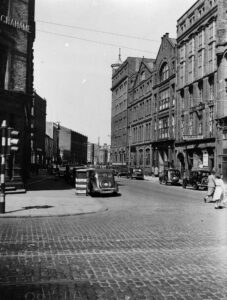
Interestingly there was always an engineering works located to the rear of no 38 at 38a Queen
Street. In the 1930s this was occupied by F A Mawhinney & Co who specialised in automobiles
and coachwork. Earlier in the early 1900s, 38a was where one of Belfast’s most important
automobile engineers started out their business – that was Leslie Porter & Co before they
relocated to larger premises on Gt Victoria Street.
Captain Leslie Porter was an
extraordinary man, being a pioneering racing driver and World War I flying hero … and all during the time he operated out of 28a Queen Street! He was often referred to as “the man who died twice” because of his adventures with early automobiles and in warfare.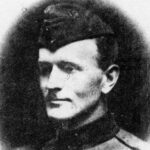
Nicholson & Morrow remained at no 32 until the late 1960s, with S O McCabe taking over no 36 from John Dickinson & Co around the same time at no 38, David W Corry maintained a boot, shoe and saddle manufactory from the early 1900s again to the 1960s.
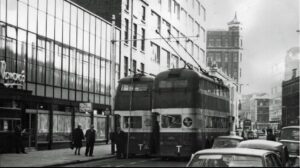 During the “troubles” which broke out in 1969, Queen Street suffered from a destructive bombing campaign very similar to other parts of the city centre. Once it played host to famous dancehalls such as Romano’s which drew thousands of people weekly for entertainment. These gradually closed because of the reluctance of people to go into the city centre at night and Queen Street became much of a ghost town after 6:00pm each evening. This photograph captures Romano’s Ballroom in the 1960s with the warehouse of Nicholson & Morrow towering up to six stories in the background at no 32 Queen Street. Strangely enough the US Consul remained on Queen Street throughout the worst periods of civil unrest, where the “Stars & Stripes” could be found flying every weekday until the consulate removed to Danesfort in South Belfast.
During the “troubles” which broke out in 1969, Queen Street suffered from a destructive bombing campaign very similar to other parts of the city centre. Once it played host to famous dancehalls such as Romano’s which drew thousands of people weekly for entertainment. These gradually closed because of the reluctance of people to go into the city centre at night and Queen Street became much of a ghost town after 6:00pm each evening. This photograph captures Romano’s Ballroom in the 1960s with the warehouse of Nicholson & Morrow towering up to six stories in the background at no 32 Queen Street. Strangely enough the US Consul remained on Queen Street throughout the worst periods of civil unrest, where the “Stars & Stripes” could be found flying every weekday until the consulate removed to Danesfort in South Belfast.
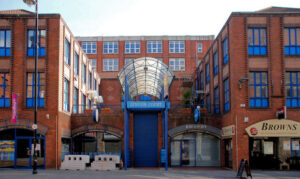 In the mid-1980s, an application was lodged with Belfast City Council by property developer Gareth Graham to develop the site of the old warehouses on 32 – 38 Queen Street as a new retail and office development to be called Lyndon Court.
In the mid-1980s, an application was lodged with Belfast City Council by property developer Gareth Graham to develop the site of the old warehouses on 32 – 38 Queen Street as a new retail and office development to be called Lyndon Court.
The new retail development was to be designed by Belfast architect Barrie Todd Associates for Audio Times Properties Limited. It comprised of a U-shaped three-story block of brick with hipped pantile roofs. Access to the upper floors would be via an external staircase with a plastic barrel vault feature above it. The new building was completed in 1987 and at first attracted some key retail tenants such as Bradbury Graphics. The offices on the upper floors were designed for smaller businesses at a time when massive office developments were going up all over Belfast for financial institutions and government departments. Because of its design, each office would have its “own door access” i.e., no requirement to go through shared access via a reception area.
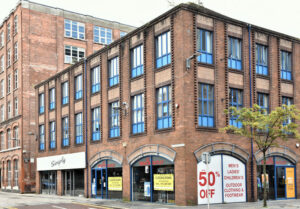 Following the financial crisis of 2008 in Ireland, the property portfolio of Lyndon Court had been passed to the National Asset Management Agency (NAMA) as had many properties which fell during that crisis. By the following decade, the retail development had failed to attract the right prestige tenant and had become reflective of Queen Street itself … that of being rather run down whilst other prestige retail developments were surging ahead in the city such as Victoria Square.
Following the financial crisis of 2008 in Ireland, the property portfolio of Lyndon Court had been passed to the National Asset Management Agency (NAMA) as had many properties which fell during that crisis. By the following decade, the retail development had failed to attract the right prestige tenant and had become reflective of Queen Street itself … that of being rather run down whilst other prestige retail developments were surging ahead in the city such as Victoria Square.
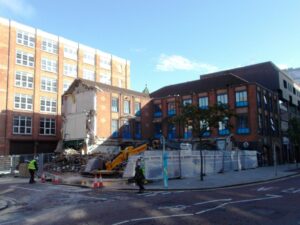 In February 2019, an application was made for planning permission which would allow for the demolition of the existing buildings at 32-38 Queen Street, allowing for the erection of a 175-bed aparthotel with associated bar, restaurant and conferencing facilities. This application was subsequently approved, and demolition of Lyndon Court took place in late 2020.
In February 2019, an application was made for planning permission which would allow for the demolition of the existing buildings at 32-38 Queen Street, allowing for the erection of a 175-bed aparthotel with associated bar, restaurant and conferencing facilities. This application was subsequently approved, and demolition of Lyndon Court took place in late 2020.
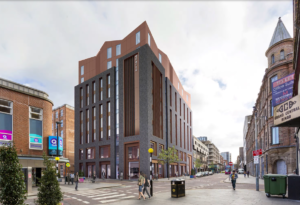 Construction of the new development is now well underway. Designed by Like Architects and developed by Oakland Holdings, the project is just one further example of the massive changes happening on Queen Street and the surrounding area.
Construction of the new development is now well underway. Designed by Like Architects and developed by Oakland Holdings, the project is just one further example of the massive changes happening on Queen Street and the surrounding area.

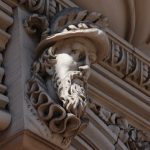 Queen Street, unlike its more upmarket neighbours to the north and west such as College Square and Wellington Place, was originally called David Street, this information coming from leases granted by the Donegall estate at the time. By 1819, it was being developed, roughly on the old town defences, hence the angle at the crossing of College Street, which would have followed the line of the town walls.
Queen Street, unlike its more upmarket neighbours to the north and west such as College Square and Wellington Place, was originally called David Street, this information coming from leases granted by the Donegall estate at the time. By 1819, it was being developed, roughly on the old town defences, hence the angle at the crossing of College Street, which would have followed the line of the town walls.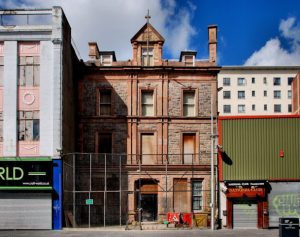 The original houses would have been substantial, but without the grandeur of those found on nearby Donegall Square beside the White linen Hall (now City Hall) and College Square beside Royal Belfast Academical Institution (Inst). As the 19th century progressed, Queen Street did however play host to some very important buildings, both commercial and institutional. The most notable of these was The Belfast Hospital for Sick Children which was established in King Street in 1873 and moved to new premises on Queen Street in April 1879.
The original houses would have been substantial, but without the grandeur of those found on nearby Donegall Square beside the White linen Hall (now City Hall) and College Square beside Royal Belfast Academical Institution (Inst). As the 19th century progressed, Queen Street did however play host to some very important buildings, both commercial and institutional. The most notable of these was The Belfast Hospital for Sick Children which was established in King Street in 1873 and moved to new premises on Queen Street in April 1879.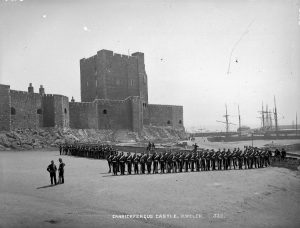 Another important building on Queen Street of the period was the Working Man’s Institute and Temperance Hall built on the corner with Castle Street. Before the days of the internet, this building contained a library of ‘upwards of 3000 carefully selected works’ in addition to a lecture hall where talks and concerts were provided “to check the increasingly bad effects of the music saloons”, where alcohol would have freely been available. This was the beginning of the Temperance Movement which was set up by both the churches and industrialists to counteract absenteeism from the workplace, particularly in the mills and factories of the day.
Another important building on Queen Street of the period was the Working Man’s Institute and Temperance Hall built on the corner with Castle Street. Before the days of the internet, this building contained a library of ‘upwards of 3000 carefully selected works’ in addition to a lecture hall where talks and concerts were provided “to check the increasingly bad effects of the music saloons”, where alcohol would have freely been available. This was the beginning of the Temperance Movement which was set up by both the churches and industrialists to counteract absenteeism from the workplace, particularly in the mills and factories of the day.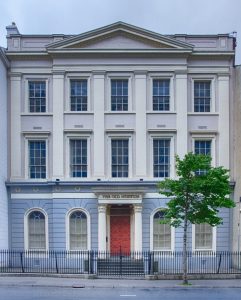
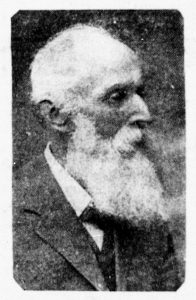 From an early age, Swanston showed a keen interest in geology, becoming a member of the highly esteemed Belfast Natural History and Philosophical Society (founded 1821) and the Belfast Naturalists Field Club which he joined in 1868. The Society met in one of Belfast’s most historic buildings, The Old Museum, which is located on College Square North just across from John Bell House. Working with Charles Lapworth, later Professor of Geology at Birmingham (the home of Student Roost)
From an early age, Swanston showed a keen interest in geology, becoming a member of the highly esteemed Belfast Natural History and Philosophical Society (founded 1821) and the Belfast Naturalists Field Club which he joined in 1868. The Society met in one of Belfast’s most historic buildings, The Old Museum, which is located on College Square North just across from John Bell House. Working with Charles Lapworth, later Professor of Geology at Birmingham (the home of Student Roost)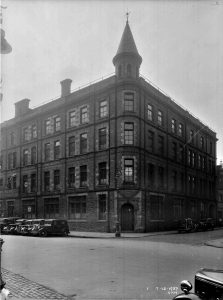 It was his business interests that brought him to Queen Street. Having formed a partnership with Thomas Bones, the two men set about establishing a linen shirt, collar and cuff manufacturing business. Since the 1850’s Belfast had become the largest producer of articles of linen manufacture in the world. The partnership of Swanston & Bones provided the manufacturers of linen clothing with the accessories they required to complete the finished products before exporting them out of the port of Belfast to every part of the Empire and the civilised world. Their first manufactory was based at 50 King Street (adjacent to Queen Street) where they made shirt collars and cuffs.
It was his business interests that brought him to Queen Street. Having formed a partnership with Thomas Bones, the two men set about establishing a linen shirt, collar and cuff manufacturing business. Since the 1850’s Belfast had become the largest producer of articles of linen manufacture in the world. The partnership of Swanston & Bones provided the manufacturers of linen clothing with the accessories they required to complete the finished products before exporting them out of the port of Belfast to every part of the Empire and the civilised world. Their first manufactory was based at 50 King Street (adjacent to Queen Street) where they made shirt collars and cuffs.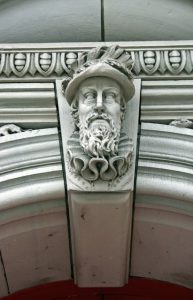 Soon the partners began to look around for larger premises and found a plot of land on the corner of Queen Street and College Street upon which was a small cottage and garden, one of the last of its type in the city. Upon purchasing the land, they commissioned one of the leading architects’ practices of the day, Young & McKenzie to design a new manufactory and warehouse for their growing business.
Soon the partners began to look around for larger premises and found a plot of land on the corner of Queen Street and College Street upon which was a small cottage and garden, one of the last of its type in the city. Upon purchasing the land, they commissioned one of the leading architects’ practices of the day, Young & McKenzie to design a new manufactory and warehouse for their growing business.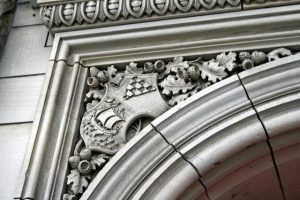
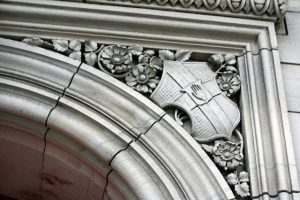
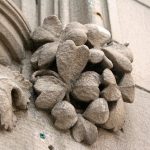 The new building extended along Queen Street towards Wellington Place. In addition to the plot of land with the cottage and garden, the partners also acquired four Georgian houses and a cabinet manufactory belonging to Messrs McCutcheon.
The new building extended along Queen Street towards Wellington Place. In addition to the plot of land with the cottage and garden, the partners also acquired four Georgian houses and a cabinet manufactory belonging to Messrs McCutcheon.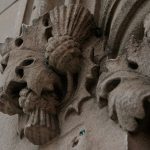 Swanston, a Scot by parentage, also demonstrated great affection towards his adopted country. Shamrock and thistle motifs are found both on the entrance and in the pediment. A similar show of his fondness for Ireland is found in his bookplate which incorporates round towers, the Giant’s Causeway, a dolmen, a harp and most prominently the castle at Carrickfergus.
Swanston, a Scot by parentage, also demonstrated great affection towards his adopted country. Shamrock and thistle motifs are found both on the entrance and in the pediment. A similar show of his fondness for Ireland is found in his bookplate which incorporates round towers, the Giant’s Causeway, a dolmen, a harp and most prominently the castle at Carrickfergus.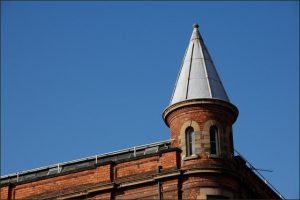 Mr Swanston developed the entire site with an imposing frontage of 150 feet to Queen Street and 80 feet to College Street, and in the process formed five distinct warehouses; Swanston & Bones taking occupation of the most prominent corner site. A semi-circular tower on the corner topped with a steeply pitched conical roof rose to a height of 75 feet, being originally covered in green slates and surmounted with a weather vane (now removed).
Mr Swanston developed the entire site with an imposing frontage of 150 feet to Queen Street and 80 feet to College Street, and in the process formed five distinct warehouses; Swanston & Bones taking occupation of the most prominent corner site. A semi-circular tower on the corner topped with a steeply pitched conical roof rose to a height of 75 feet, being originally covered in green slates and surmounted with a weather vane (now removed).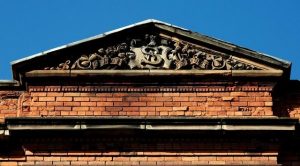 And so, William Swanston had achieved his dream of establishing a successful business, along with his partner, at the same time erecting one of the most impressive buildings in the city centre. The status of a city had been conferred upon Belfast in 1888 during a visit to Ireland by Queen Victoria, just two years before Swanston House was built.
And so, William Swanston had achieved his dream of establishing a successful business, along with his partner, at the same time erecting one of the most impressive buildings in the city centre. The status of a city had been conferred upon Belfast in 1888 during a visit to Ireland by Queen Victoria, just two years before Swanston House was built.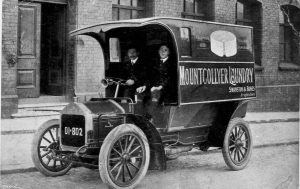 Although he was extremely proud of his new premises, the partnership soon outgrew even this building, and the company built a new shirt, collar and cuff manufactory on the Limestone Road, which he called the Mountcollyer Factory (below). By 1901, his son Robert had joined him in the business, looking after the warehouse side and distribution of the company’s products across Europe. Swanston was by this time 59 years old, but still took an active part in the day to day running of the firm. They developed a laundry on the site which would have serviced other linen manufacturers in the city and to collect and deliver the products, the company built up a fleet of motorised vehicles, some of the earliest in the city. Such goods would have previously been moved around the city by horse and cart.
Although he was extremely proud of his new premises, the partnership soon outgrew even this building, and the company built a new shirt, collar and cuff manufactory on the Limestone Road, which he called the Mountcollyer Factory (below). By 1901, his son Robert had joined him in the business, looking after the warehouse side and distribution of the company’s products across Europe. Swanston was by this time 59 years old, but still took an active part in the day to day running of the firm. They developed a laundry on the site which would have serviced other linen manufacturers in the city and to collect and deliver the products, the company built up a fleet of motorised vehicles, some of the earliest in the city. Such goods would have previously been moved around the city by horse and cart.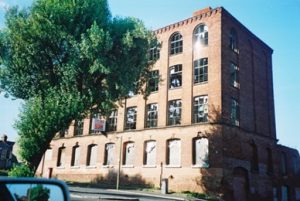
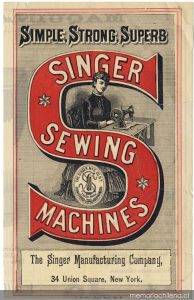 In 1901 the Singer Manufacturing Co moved into number 43 Queen Street, where they would remain for several decades to follow until the early 1970s. Founded in New York in in 1851 by Isaac Merritt Singer, the company’s sewing machines would go on to revolutionise home manufacture of clothing for the next 165 years. These were distributed all over Ireland from the company’s warehouse on Queen Street, managed by Mr James Marshall, having been manufactured in the UK at the company’s factory on Clydebank in Scotland, which was opened in1867.
In 1901 the Singer Manufacturing Co moved into number 43 Queen Street, where they would remain for several decades to follow until the early 1970s. Founded in New York in in 1851 by Isaac Merritt Singer, the company’s sewing machines would go on to revolutionise home manufacture of clothing for the next 165 years. These were distributed all over Ireland from the company’s warehouse on Queen Street, managed by Mr James Marshall, having been manufactured in the UK at the company’s factory on Clydebank in Scotland, which was opened in1867.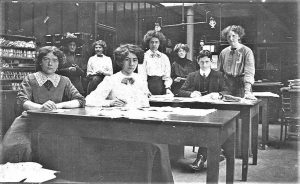
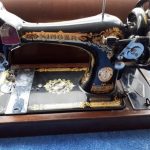 At Clydebank, with nearly a million square feet of space and almost 7,000 employees, it was possible to produce on average 13,000 machines a week, making it the largest sewing machine factory in the world (right)… another first, along with the largest shipyard, ropeworks and linen thread manufactory, all of which could be found in Belfast!
At Clydebank, with nearly a million square feet of space and almost 7,000 employees, it was possible to produce on average 13,000 machines a week, making it the largest sewing machine factory in the world (right)… another first, along with the largest shipyard, ropeworks and linen thread manufactory, all of which could be found in Belfast!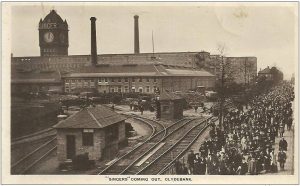
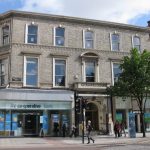
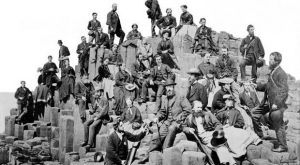
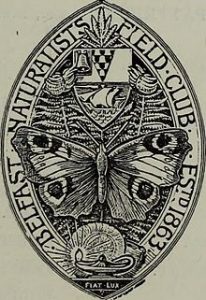 He left an estate in probate worth £10,414, approximately £680,000 today.
He left an estate in probate worth £10,414, approximately £680,000 today.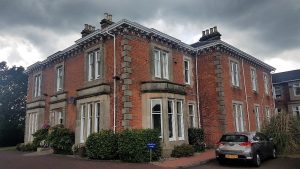
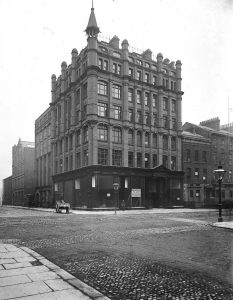
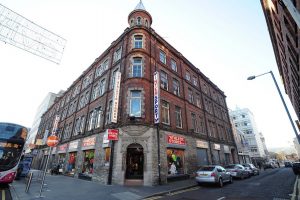 The other half of the building was also converted for retail becoming the showrooms of EDCO – the Educational Company Limited. This was and still is, Ireland’s leading educational publisher, and retailed all sorts of media for students and teachers before the days of the Early Learning Centre. Perhaps it was the advent of Competition from these new retaillers, that by 2005, both busineses had decided to cease trading on Queen Street and Swanston’s buildings became vacant and unloved.
The other half of the building was also converted for retail becoming the showrooms of EDCO – the Educational Company Limited. This was and still is, Ireland’s leading educational publisher, and retailed all sorts of media for students and teachers before the days of the Early Learning Centre. Perhaps it was the advent of Competition from these new retaillers, that by 2005, both busineses had decided to cease trading on Queen Street and Swanston’s buildings became vacant and unloved.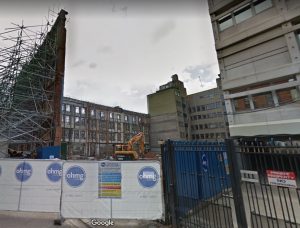
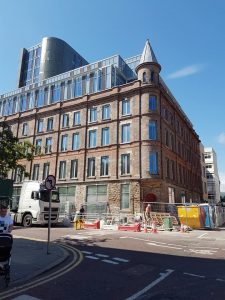 Work commenced in August 2016, demolishing the interiors of what had become a very unstable set of buildings (above). Using the latest construction support systems, the original Victorian façade was held in place, whilst the new building was erected floor by floor over the next two years. The new building, to be known as Swanston House was completed in August 2018 – the accommodation comprising of 317 bed spaces in a mixture of cluster bedrooms and studios located in a 7-storey low rise section and a 13-storey tower (see left).
Work commenced in August 2016, demolishing the interiors of what had become a very unstable set of buildings (above). Using the latest construction support systems, the original Victorian façade was held in place, whilst the new building was erected floor by floor over the next two years. The new building, to be known as Swanston House was completed in August 2018 – the accommodation comprising of 317 bed spaces in a mixture of cluster bedrooms and studios located in a 7-storey low rise section and a 13-storey tower (see left).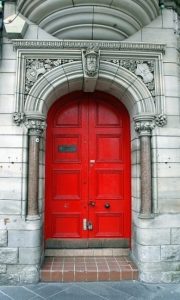 William Swanston would be proud of the impressive and beautiful conversion of the building that still bears his name today, managed by Student Roost, one of the most dynamic student accommodation providers in the UK. You’re more than welcome!
William Swanston would be proud of the impressive and beautiful conversion of the building that still bears his name today, managed by Student Roost, one of the most dynamic student accommodation providers in the UK. You’re more than welcome!